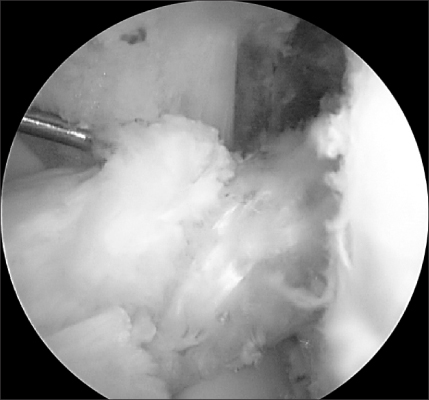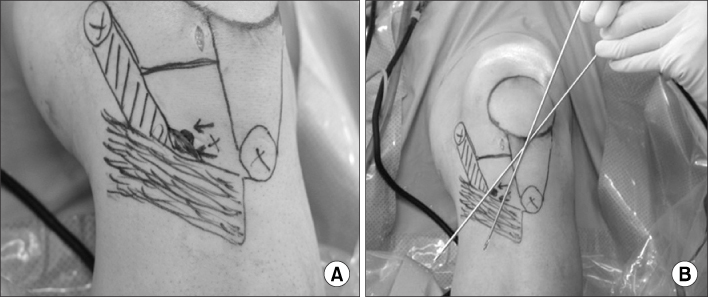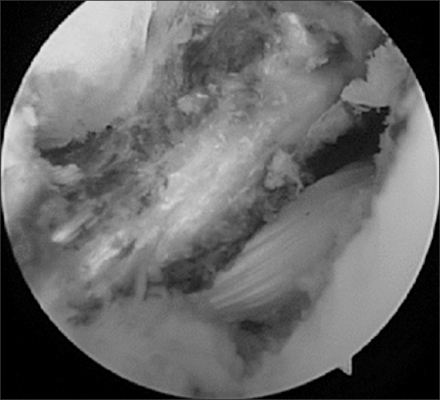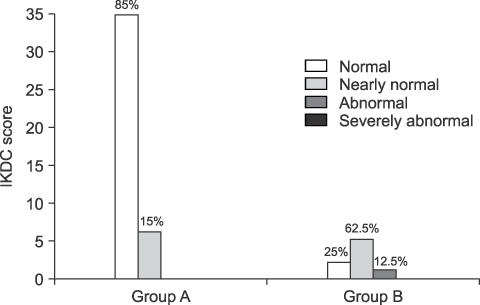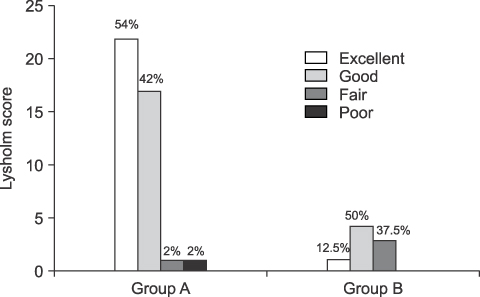J Korean Orthop Assoc.
2010 Feb;45(1):1-9. 10.4055/jkoa.2010.45.1.1.
Rotary Instability after Anterior Cruciate Ligament Reconstruction with Single BTB Tendon
- Affiliations
-
- 1Department of Orthopedic Surgery, Inha University School of Medicine, Incheon, Korea. m9kim@inha.ac.kr
- KMID: 2185587
- DOI: http://doi.org/10.4055/jkoa.2010.45.1.1
Abstract
- PURPOSE
To analyze both the functional restoration and recovery of rotational and anterior-posterior stability after a single bundle ACL reconstruction using a BTB tendon.
MATERIALS AND METHODS
A total of 52 patients were evaluated with an average follow up period of 32 months. A Lachman test, KT-2000 arthrometer, and Pivot shift test were performed to analyze the AP and rotational stability of the patients. The IKDC and Lysholm score was then used to evaluate the clinical results of the patients. The correlation between femoral tunnel angle and recovery of rotational stability was evaluated to determine the association between the two variables. This study also evaluated how the recovery of rotational stability affects the functional recovery of the patients.
RESULTS
At the final follow up, the results indicated significant improvement according to the negative Lachman tests in 40 cases (76%), with an average of 2.92 mm anterior translation in the KT-2000 arthrometer and negative Pivot shift tests in 41 cases (79%)(p<0.05). The Lysholm and IKDC scores also showed significant improvement (p<0.05). Throughout the study, Group A was designated as those with <5 mm anterior translation and a negative Pivot shift test whereas Group B had positive test results. In Group A, the results showed 35 normal (85%), and 6 near normal (15%) cases in the IKDC score system, whereas Group B showed 2 normal (25%) and 5 near normal (62.5%) cases. Group A had an average of 89.3 in the Lysholm score system whereas Group B had a score of 60.5. On the knee tunnel view, Group A showed an average femoral tunnel angle of 49.2degrees, whereas Group B showed 63.5degrees.
CONCLUSION
Decreasing the inclination of the BTB tendon using a transtibial femoral tunnel angle at either 10'30 or 1'30 will result in an excellent clinical outcome by achieving both anterior and rotational stability when operating a single bundle ACL reconstruction.
MeSH Terms
Figure
Reference
-
1. Amis AA, Dawkins GP. Functional anatomy of the anterior cruciate ligament. Fibre bundle actions related to ligament replacements and injuries. J Bone Joint Surg Br. 1991. 73:260–267.
Article2. Zantop T, Herbort M, Raschke MJ, Fu FH, Petersen W. The role of the anteromedial and posterolateral bundles of the anterior cruciate ligament in anterior tibial translation and internal rotation. Am J Sports Med. 2007. 35:223–227.
Article3. Aglietti P, Giron F, Cuomo P, Losco M, Mondanelli N. Single- and double-incison double bundle ACL reconstrcution. Clin Othop Relat Res. 2007. 454:108–113.4. Belzer JP, Freedman MJ. McGinty HB, editor. Cruciate ligament reconstruction using allograft tissue. 1996. New York: Lippincott-Raven Press;551–572.5. Meredick RB, Vance KJ, Appleby D, Lubowitz JH. Outcome of single-bundle versus double-bundle reconstruction of the anterior cruciate ligament: a meta-analysis. Am J Sports Med. 2008. 36:1414–1421.6. Samuelson TS, Drez D Jr, Maletis GB. Anterior cruciate liga-ment graft rotation. Reproduction of normal graft rotation. Am J Sports Med. 1996. 24:67–71.7. Markolf KL, Park S, Jackson SR, McAllister DR. Anterior-posterior and rotatory stability of single and double-bundle anterior cruciate ligament reconstructions. J Bone Joint Surg Am. 2009. 91:107–118.
Article8. Yagi M, Kuroda R, Nagamune K, Yoshiya S, Kurosaka M. Double-bundle ACL reconstruction can improve rotational stability. Clin Orthop Relat Res. 2007. 454:100–107.
Article9. Yamamoto Y, Hsu WH, Woo SL, Van Scyoc AH, Takakura Y, Debski RE. Knee stability and graft function after anterior cruciate ligament reconstruction: a comparison of a lateral and anatomical femoral tunnel placement. Arm J Sports Med. 2004. 32:1825–1832.10. Shelbourne KD, Nitz P. Accelerated rehabilitation after ante-rior cruciate ligament reconstruction. Am J Sports Med. 1990. 18:292–299.
Article11. Rosenberg TD, Franklin JL, Baldwin GN, Nelson KA. Extensor mechanism function after patella tendon graft harvest for anterior cruciate ligament reconstruction. Am J Sports Med. 1992. 20:519–526.12. Buss DD, Warren RF, Wickiewicz TL, Galinat BJ, Panariello R. Arthroscopically assisted reconstruction of the anterior cruciate ligament with use of autogenous patellar-ligament grafts. Results after twenty-four to forty-two months. J Bone Joint Surg Am. 1993. 75:1346–1355.
Article13. Feller JA, Webster KE. A randomized comparison of patellar tendon and hamstring tendon anterior cruciate ligament recon-struction. Am J Sports Med. 2003. 31:564–573.
Article14. Jepsen CF, Lundberg-Jensen AK, Faunoe P. Does the position of the femoral tunnel affect the laxity or clinical outcome of the anterior cruciate ligament-reconstructed knee? A clinical, prospective, randomized, double-blind study. Arthroscopy. 2007. 12:1326–1333.
Article15. Kanamori A, Zeminski J, Rudy TW, Li G, Fu FH, Woo SL. The effect of axial tibial torque on the function of the anterior cruciate ligament: a biomechanical study of a simulated pivot shift test. Arthroscopy. 2002. 18:394–398.16. Yasuda K, Kondo E, Ichiyama , Tanabe Y, Tohyama H. Clinical evaluation of anatomic double-bundle anterior cruciate liga-ment reconstruction procedure using hamstring tendon grafts: comparisons among 3 different procedures. Arthroscopy. 2006. 22:240–251.
Article17. Mae T, Shino K, Miyama T, et al. Single- versus two-femoral socket anterior cruciate ligament reconstruction technique: Biomechanical analysis using a robotic simulator. Arthroscopy. 2001. 17:708–716.18. Seon JK, Park SJ, Lee KB, Yoon TR, Seo HY, Song EK. Stability comparison of anterior cruciate ligament between double- and single-bundle reconstructions. Int Orthop. 2009. 33:425–429.
Article19. Adachi N, Ochi M, Uchio Y, Iwasa J, Kuriwaka M, Ito Y. Recon-struction of the anterior cruciate ligament. Single- versus double-bundle multistranded hamstring tendons. J Bone Joint Surg Br. 2004. 86:515–520.20. Bach BR Jr, Tradonsky S, Bojchuk J, Levy ME, Bush-Joseph CA, Khan NH. Arthroscopically assisted anterior cruciate ligament reconstruction using patellar tendon autograft. Five- to nine-year follow-up evaluation. Am J Sports Med. 1998. 26:20–29.21. Harner CD, Poheling GG. Double bundle or double trouble? Arthroscopy. 2004. 20:1013–1034.
Article22. Lee MC, Seong SC, Lee S, et al. Vertical femoral tunnel placement results in rotational knee laxity after anterior cruciate ligament reconstruction. Arthroscopy. 2007. 23:771–778.
Article23. Muneta T, Koga H, Mochizuki T, et al. A prospective randomized study of 4-strand semitendinosus tendon anterior cruciate ligament reconstruction comparing single-bundle and double-bundle techniques. Arthroscopy. 2007. 23:618–628.
Article24. Loh JC, Fukuda Y, Tsuda E, Steadman RJ, Fu FH, Woo SL. Knee stability and graft function following anterior cruciate ligament reconstruction: comparison between 11 o'clock and 10 o'clock fe-moral tunnel placement. 2002 Richard O'Connor Award paper. Arthroscopy. 2003. 19:297–304.25. Scopp JM, Jasper LE, Belkoff SM, Moorman CT 3rd. The effect of oblique femoral tunnel placement on rotational constraint of the knee reconstrcuted using patellar tendon autografts. Arthroscopy. 2004. 20:294–299.26. Lane CG, Warren R, Pearle AD. The pivot shift. J Am Acad Orthop Surg. 2008. 16:679–688.
Article27. Lee BI, Kwon SW, Kim JB, Choi HS, Min KD. Comparison of clinical results according to amount of preserved remnant in arth-roscopic anterior cruciate ligament reconstruction using qua-drupled hamstring graft. Arthroscopy. 2008. 24:560–568.
Article28. Ochi M, Adachi N, Deie M, Kanaya A. Anterior cruciate ligament augmentation procedure with a 1-incision technique: anteromedial bundle or posterolateral bundle reconstruction. Arthroscopy. 2006. 22:463.e1–463.e5.
Article29. Cooper DE, Deng XH, Burstein AL, Warren RF. The strength of the central third patellar tendon graft. Am J Sports Med. 1993. 21:818–824.
Article
- Full Text Links
- Actions
-
Cited
- CITED
-
- Close
- Share
- Similar articles
-
- The Reconstruction of Anterior Cruciate Ligament Using Patellar Tendon under Arthroscopy
- Anterior Cruciate Ligament Reconstruction using Patellar tendon with Kennedy-LAD
- What Has Been Learned in Anterior Cruciate Ligament Reconstruction during the Past 20 Years?
- Anterior Cruciate Ligament Reconstruction with Achilles Tendon Allograft
- Reconstuction of the Anterior and Posterior Cruciate Ligament Injury Associated with Traumatic Knee Joint Dislocation: Six Cases of Reconstruction Using Autogenous Achilles Tendon

